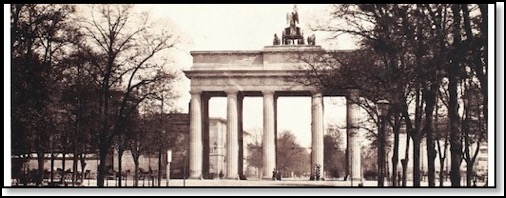History
Devils Tower
13/06/24 07:17 Filed in: Travel
| We did our jaunt to South Dakota at the end of May. On previous trips we saw other landmarks that draw tourists and interest. One is the famous Devils Tower. How did Devils Tower get its name. The previous info should give you and Idea. |
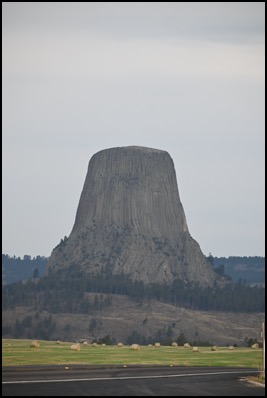
Comments
Human Species
01/06/24 13:56 Filed in: History | Animal Kingdom
Most of us do not realize that there have been around 21 human species that have lived on this planet Earth. I came across this article that gives an introduction to the past history of humans.
| "Each one of the billions of people living on Earth today belongs to the same species: |
| The first humans in the same genus as |
Memorial Day 2024
27/05/24 15:18 Filed in: Holiday
This Memorial Day was a warm, sunny day. After getting some necessary tasks in the garden done, we went to participate in the block potluck party on Robbins Way with Scott, Olisha, and the girls. Memorial Day should be spent with family or another wonderful way to pay respect is in Washington DC, especially at Arlington Cemetery.
The history of early Memorial Day or Decoration Day in that time follows:
"As the American Civil War came to an end in 1865, communities across the U.S. honored fallen soldiers through local ceremonies at burial sites. On May 30, 1868, the first national ceremony of this kind took place on a day that would come to be known as Memorial Day — though at the time, it was called “Decoration Day.”
A few weeks before the ceremony, John Logan, head of the Grand Army of the Republic, a Union veterans organization, issued a proclamation urging Americans to decorate Civil War soldiers’ graves with springtime’s “choicest” blooms. Logan stated that the May 30 commemoration would be “designated for the purpose of strewing with flowers or otherwise decorating the graves of comrades who died in defense of their country.” About 5,000 people gathered at Arlington National Cemetery for the first official Decoration Day observance. Along with flowers, each grave was adorned with a small American flag.
By the end of the 19th century, Decoration Day ceremonies were taking place on May 30 throughout the country. The name had started to evolve by this time, too; people began using the term “Memorial Day” instead. That moniker, however, didn’t become common until after World War II, and Congress didn’t make the name change official until 1967. A year later, Congress passed the Uniform Monday Holiday Act, declaring that certain federal holidays would be observed on Mondays, including Memorial Day, which was to be commemorated annually on the last Monday in May. Today, the holiday honors all Americans who have died in military service."
The history of early Memorial Day or Decoration Day in that time follows:
"As the American Civil War came to an end in 1865, communities across the U.S. honored fallen soldiers through local ceremonies at burial sites. On May 30, 1868, the first national ceremony of this kind took place on a day that would come to be known as Memorial Day — though at the time, it was called “Decoration Day.”
A few weeks before the ceremony, John Logan, head of the Grand Army of the Republic, a Union veterans organization, issued a proclamation urging Americans to decorate Civil War soldiers’ graves with springtime’s “choicest” blooms. Logan stated that the May 30 commemoration would be “designated for the purpose of strewing with flowers or otherwise decorating the graves of comrades who died in defense of their country.” About 5,000 people gathered at Arlington National Cemetery for the first official Decoration Day observance. Along with flowers, each grave was adorned with a small American flag.
By the end of the 19th century, Decoration Day ceremonies were taking place on May 30 throughout the country. The name had started to evolve by this time, too; people began using the term “Memorial Day” instead. That moniker, however, didn’t become common until after World War II, and Congress didn’t make the name change official until 1967. A year later, Congress passed the Uniform Monday Holiday Act, declaring that certain federal holidays would be observed on Mondays, including Memorial Day, which was to be commemorated annually on the last Monday in May. Today, the holiday honors all Americans who have died in military service."
Off To The...
We are off on a 12 day trip to see the family and grandchildren in South Dakota. A bit of a reverse trek for our families who in part came from the area or places in the MidWest.
Now a fun fact about the Oregon Trail since I had both sides of my paternal grandmother's side of the family come on the Oregon Trail in 1844 and 1852.
"It’s often thought that the Oregon Trail was made easier by the covered wagons that have become synonymous with the grueling journey, but that’s only partially true. Those wagons weren’t actually for people, who walked most or all of the trail’s 2,000 miles from Independence, Missouri, to Oregon City, Oregon. They were for the supplies that hopeful settlers deemed necessary for the trek, pulled by mules and oxen. Indeed, people who were ferried by wagons had a habit of falling out as the vehicles didn’t have springs and thus bounced around a lot; some folks were even run over by other wagons or trampled by beasts of burden after falling. As for those walking, many of the children didn’t have shoes.
So while we often romanticize that months-long journey as being emblematic of the “American Dream” and westward expansion, it was above all else a brutal quest that many did not survive."
Now a fun fact about the Oregon Trail since I had both sides of my paternal grandmother's side of the family come on the Oregon Trail in 1844 and 1852.
"It’s often thought that the Oregon Trail was made easier by the covered wagons that have become synonymous with the grueling journey, but that’s only partially true. Those wagons weren’t actually for people, who walked most or all of the trail’s 2,000 miles from Independence, Missouri, to Oregon City, Oregon. They were for the supplies that hopeful settlers deemed necessary for the trek, pulled by mules and oxen. Indeed, people who were ferried by wagons had a habit of falling out as the vehicles didn’t have springs and thus bounced around a lot; some folks were even run over by other wagons or trampled by beasts of burden after falling. As for those walking, many of the children didn’t have shoes.
So while we often romanticize that months-long journey as being emblematic of the “American Dream” and westward expansion, it was above all else a brutal quest that many did not survive."
Roots of the Kentucky Derby
11/05/24 08:47 Filed in: History
Having been to see some horse racing at Churchill Downs in Louisville, KY, I find the horse race of the Kentucky Derby fascinating. I didn't think I'd like to watch horse racing yet I did.
Here is some background on how this race began…
"The Kentucky Derby is a global sports spectacle and, in the eyes of many, America’s definitive sporting tradition. The event was forged, remarkably, by two of the great epic events in United States history: the triumph of the Lewis and Clark Expedition and the tragedy of the Civil War.The bluegrass seeds of the world's most famous horse race were planted by a fascinating man with a uniquely American heritage. His name: Meriwether Lewis Clark Jr., grandson of Lewis Clark, one-half of the Lewis-Clark Expedition. He founded both the Kentucky Derby, which has been run every year since 1875, and the Louisville Jockey Club, later known as Churchill Downs."
Here is some background on how this race began…
"The Kentucky Derby is a global sports spectacle and, in the eyes of many, America’s definitive sporting tradition. The event was forged, remarkably, by two of the great epic events in United States history: the triumph of the Lewis and Clark Expedition and the tragedy of the Civil War.The bluegrass seeds of the world's most famous horse race were planted by a fascinating man with a uniquely American heritage. His name: Meriwether Lewis Clark Jr., grandson of Lewis Clark, one-half of the Lewis-Clark Expedition. He founded both the Kentucky Derby, which has been run every year since 1875, and the Louisville Jockey Club, later known as Churchill Downs."
Lincoln and Secret Service
06/05/24 14:36 Filed in: History
An interesting Presidential history fact:
On April 14, 1865, just hours before he was tragically shot by John Wilkes Booth at Ford’s Theatre in Washington, D.C., President Abraham Lincoln signed legislation creating the Secret Service. At the time, however, the new department’s purpose was not to provide presidential protection — it was to combat counterfeit currency.
By the end of the Civil War, nearly one-third of the U.S. currency in circulation was forged; the Secret Service was founded as a bureau within the Treasury Department to rehabilitate and safeguard the country’s monetary system. The night of Lincoln’s assassination, just one local police officer was assigned to escort the President from the White House to the theater, but the officer’s whereabouts at the time of the shooting are unknown. It was not until after the assassination of President William McKinley in 1901, when Vice President Theodore Roosevelt took over, that the Secret Service’s mandate was expanded to include the protection of the President.
Theodore Roosevelt attended and watched Lincoln's funeral train at the age of six. Another Mt. Rushmore historical incident.
On April 14, 1865, just hours before he was tragically shot by John Wilkes Booth at Ford’s Theatre in Washington, D.C., President Abraham Lincoln signed legislation creating the Secret Service. At the time, however, the new department’s purpose was not to provide presidential protection — it was to combat counterfeit currency.
By the end of the Civil War, nearly one-third of the U.S. currency in circulation was forged; the Secret Service was founded as a bureau within the Treasury Department to rehabilitate and safeguard the country’s monetary system. The night of Lincoln’s assassination, just one local police officer was assigned to escort the President from the White House to the theater, but the officer’s whereabouts at the time of the shooting are unknown. It was not until after the assassination of President William McKinley in 1901, when Vice President Theodore Roosevelt took over, that the Secret Service’s mandate was expanded to include the protection of the President.
Theodore Roosevelt attended and watched Lincoln's funeral train at the age of six. Another Mt. Rushmore historical incident.
A Historical Surprise
04/05/24 07:30 Filed in: Family
I visited again the Genealogy Room at the Lebanon Library to learn about how books are categorized there. It was an interesting few hours and a good learning experience. One task we were asked to do was to find a book using the cataloguing technique. In addition to finding a book on the Early Families of Berlin, there was a book about the Petersons of Peterson Butte. I flipped open to a middle page and right there was a photo of my paternal great-grandmother and grandmother. Neither I had met since they died before I was born. What a special surprise. Please enjoy the photo I took with my camera phone of the photo of them in earlier days.


Stillness At Appomattox
Bob and I were staying at a lovely B&B just outside Charlottesville, VA while doing a drive around northern Virginia. We were seeing historic sights, beautiful countryside, and battlefields. At one breakfast there, we heard another party at the B&B talk about a visit to the Appomattox battlefield area and where Lee surrendered to Grant at the end of the Civil War. They commented that the area seemed to have an extra "quiet" and "hush", likely a stillness to it due to the significance of the surrender. Bob and I talked and decided it was worth a 3 hour drive to the location to see it. It was definitely worth a visit and there was a stillness to it.
Here is info on the site from the list of battlefields to visit:
No battlefield tour is complete without a visit to the village of Appomattox Court House, the place where the American Civil War ended on April 9, 1865. After a series of battles known as the Appomattox Campaign, which engaged almost 90,000 soldiers, Confederate General Robert E. Lee officially surrendered to Union General Ulysses S. Grant at McLean House, bringing an end to the war. The park covers approximately 1,800 acres and encompasses many of the village’s original structures and over two dozen restored buildings, including a reconstruction of the McLean House. Visitors can walk on the same dirt road where Lee’s army folded their flags, visit the Confederate cemetery, and discover the quaint village of Appomattox Court House.
Our photo of McLean House.

An old photo from an internet site.
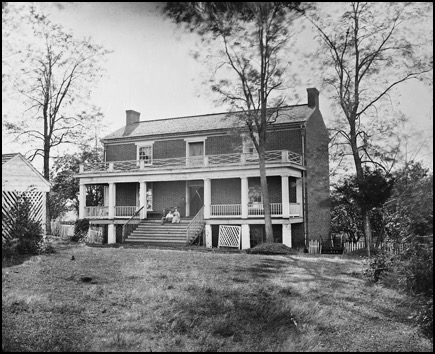
Here is info on the site from the list of battlefields to visit:
No battlefield tour is complete without a visit to the village of Appomattox Court House, the place where the American Civil War ended on April 9, 1865. After a series of battles known as the Appomattox Campaign, which engaged almost 90,000 soldiers, Confederate General Robert E. Lee officially surrendered to Union General Ulysses S. Grant at McLean House, bringing an end to the war. The park covers approximately 1,800 acres and encompasses many of the village’s original structures and over two dozen restored buildings, including a reconstruction of the McLean House. Visitors can walk on the same dirt road where Lee’s army folded their flags, visit the Confederate cemetery, and discover the quaint village of Appomattox Court House.
Our photo of McLean House.

An old photo from an internet site.

Chalmette Battlefield Next
27/02/24 11:07 Filed in: History
Another one of the six battlefields one can visit and we have is in Louisiana, just outside New Orleans…
Located downriver from New Orleans, Chalmette Battlefield was the site of the last great battle of the War of 1812, fought between the U.S. and Great Britain. Although the Treaty of Ghent was signed in late 1814, the war continued. On January 8, 1815, General Andrew Jackson assembled troops from across Louisiana and the southeastern U.S. to defeat the British military and prevent them from gaining control of a critical port on the Mississippi River. The Battle of New Orleans was hailed as the final victory in the “Second War of Independence,” and for decades it was celebrated as a national holiday, much like the Fourth of July. A visit to Chalmette Battlefield offers the chance to walk in the footsteps of General Jackson (who went on to become the seventh U.S. President) and his troops. It contains a reconstructed American rampart, an original home from the 1830s, and the stunning,100-foot-high Chalmette Monument. Delve further into the history of the battle site via films and exhibits at the visitor center, where you’ll find outdoor exhibits, self-guided tours, and daily ranger talks. Also of interest is Chalmette National Cemetery: Established during the Civil War in 1864, it shelters more than 14,000 graves of Americans, dating from the War of 1812 to the Vietnam War.
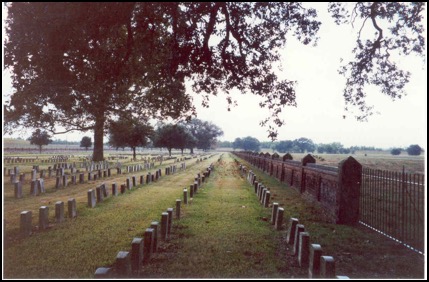
Located downriver from New Orleans, Chalmette Battlefield was the site of the last great battle of the War of 1812, fought between the U.S. and Great Britain. Although the Treaty of Ghent was signed in late 1814, the war continued. On January 8, 1815, General Andrew Jackson assembled troops from across Louisiana and the southeastern U.S. to defeat the British military and prevent them from gaining control of a critical port on the Mississippi River. The Battle of New Orleans was hailed as the final victory in the “Second War of Independence,” and for decades it was celebrated as a national holiday, much like the Fourth of July. A visit to Chalmette Battlefield offers the chance to walk in the footsteps of General Jackson (who went on to become the seventh U.S. President) and his troops. It contains a reconstructed American rampart, an original home from the 1830s, and the stunning,100-foot-high Chalmette Monument. Delve further into the history of the battle site via films and exhibits at the visitor center, where you’ll find outdoor exhibits, self-guided tours, and daily ranger talks. Also of interest is Chalmette National Cemetery: Established during the Civil War in 1864, it shelters more than 14,000 graves of Americans, dating from the War of 1812 to the Vietnam War.

Six Must See Battlefields
26/02/24 18:02 Filed in: History
While reading through a Daily Passport email, one of their story leads was about six must-see battlefields in the United States. We have visited all six at some point. I will start with the last one we visited last October, Shiloh Battlefield, located in southern Tennessee just over the Tennessee-Mississippi border. The largest loss of life in a battle in the U.S. and in some respects a draw between the Union and Rebel forces.
From the article:
The Battle of Shiloh, also known as the Battle of Pittsburg Landing, was one of the most significant battles in the Mississippi Valley Campaign of the Civil War. The Union’s victory on April 7, 1862, came at a high cost, resulting in more casualties than in all of America’s previous wars combined. Occupying over 5,000 acres, Shiloh National Military Park offers visitors the chance to discover several historic sites. These include the Corinth Battlefield Unit, which preserves the Siege and Battle of Corinth, and the Shiloh National Cemetery, the resting place of around 4,000 fallen soldiers. Also found here are the Shiloh Indian Mounds, an archeological remnant of the South Appalachian Mississippi culture that lived in the area around 1200 CE. A great way to explore the park is by driving its 12.7-mile, 22-stop self-guided tour of the battlefield. Alternatively, visitors can hike along trails or ride a bicycle or e-bike around the paved roads. Whichever way you get around, you’ll get the chance to spot local wildlife, including 186 bird species, such as the majestic bald eagle and great-horned owl.
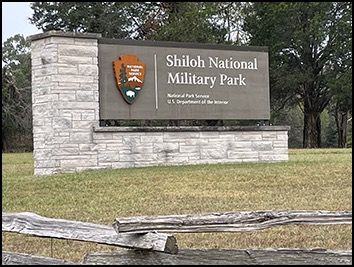
From the article:
The Battle of Shiloh, also known as the Battle of Pittsburg Landing, was one of the most significant battles in the Mississippi Valley Campaign of the Civil War. The Union’s victory on April 7, 1862, came at a high cost, resulting in more casualties than in all of America’s previous wars combined. Occupying over 5,000 acres, Shiloh National Military Park offers visitors the chance to discover several historic sites. These include the Corinth Battlefield Unit, which preserves the Siege and Battle of Corinth, and the Shiloh National Cemetery, the resting place of around 4,000 fallen soldiers. Also found here are the Shiloh Indian Mounds, an archeological remnant of the South Appalachian Mississippi culture that lived in the area around 1200 CE. A great way to explore the park is by driving its 12.7-mile, 22-stop self-guided tour of the battlefield. Alternatively, visitors can hike along trails or ride a bicycle or e-bike around the paved roads. Whichever way you get around, you’ll get the chance to spot local wildlife, including 186 bird species, such as the majestic bald eagle and great-horned owl.

Dracula Beckons with Halloween
04/10/22 10:10 Filed in: Books
Halloween is coming! The last and latest Halloween movie will be out on the 14th.
But let's start with the novel, Dracula, written by Bram Stoker.
Here are some facts found in a recent fact of the day email.
But let's start with the novel, Dracula, written by Bram Stoker.
Here are some facts found in a recent fact of the day email.
| "If you know anything about Transylvania, it’s probably that Dracula calls it home. Yet the author of Dracula, Irish writer Bram Stoker, never even visited Romania’s spookiest region. The town of Whitby, England — home to a 13th-century monastery called Whitby Abbey, which is surrounded by gravestones and has been in ruins for hundreds of years — was actually the most direct influence on the setting of the 1897 vampire novel. Stoker spent four weeks in Whitby between July and August of 1890, a visit that helped inspire his depiction of Dracula’s lair." There have been 272+ depictions of Dracula in film. Largest number of any character. It took Bram Stoker 7 years to write the novel; he wrote 11 other novels beyond Dracula. |
Dubrovnik the Ancient city
25/04/20 19:11 Filed in: History
During the mid to late 1300s, the Black Death as a plague raged around the world and into Europe. Venice was one city that was a port of entry for the disease. In fact, the word quarantine is rooted in Italian.
"The word “quarantine” has Italian roots: in an effort to protect coastal cities from the Black Death ravaging 14th-Century Europe, ships arriving in Venice from infected ports were required to sit at anchor for 40 days (quaranta giorni) before landing, a practice that eventually became known as quarantine – derived from ‘quarantino’, the Italian word for a 40-day period."
In addition, across the Adriatic Sea, the early city of Ragusa (later Dubrovnik) passed a law preventing ships and trade caravans from entering the city until they submitted to 30 days of isolation.
More about these quarantine medieval cities here.
"The word “quarantine” has Italian roots: in an effort to protect coastal cities from the Black Death ravaging 14th-Century Europe, ships arriving in Venice from infected ports were required to sit at anchor for 40 days (quaranta giorni) before landing, a practice that eventually became known as quarantine – derived from ‘quarantino’, the Italian word for a 40-day period."
In addition, across the Adriatic Sea, the early city of Ragusa (later Dubrovnik) passed a law preventing ships and trade caravans from entering the city until they submitted to 30 days of isolation.
More about these quarantine medieval cities here.
The Long Goodbye and Inauguration
20/01/17 10:33 Filed in: Interests
Today Barack Obama exits as 44th president and Donald Trump succeeds as the 45th. It seems like it was a very long goodbye by Obama and I was among those who looked forward to moving past his presidency. I felt he was dangerous to the Constitution and also safety of the American citizen. I don't like the interest groups who supported him and he made it clear through his actions he did not support all the people, just the ones who agreed with him. I wish I could say national healing would start but there is too much division now in classes and political thought. I don't think we can come together unless it is an outside threat. A shame.
Shell Grotto in Margate
28/07/16 08:42 Filed in: Interests
Noah's Ark is There
22/07/16 08:56 Filed in: Interests
There are ancient depictions of Noah's Ark and the parting of the Red Sea. They have been found in an ancient synagogue in northern Israel. History comes alive through time and from work of the past.
Newfoundland
15/07/16 08:15 Filed in: Interests
Another spot that Bob and I would like to visit is Newfoundland. We were closer than usual when we were in the Canadian Maritimes. We read a fascinating book about this province years ago and have wanted to visit since. There is a historical site, L'Anse Aux Meadow, which is on the uppermost northern tip of the province. I'd love to see this area though it is a challenge to get there in a way. I came across this description of one intrepid traveler who made the journey.
Solving a Stonehenge Mystery
14/06/16 07:47 Filed in: Interests
So how did the prehistoric Britons get the stones of Stonehenge to there from a quarry in Wales. You have to read this link to find out.
Roman London
13/06/16 07:44 Filed in: Interests
A significant archeological finding was recently discovered in London offering more information on Roman London times.
"Archaeologists announced Wednesday they have discovered hundreds of writing tablets from Roman London — including the oldest handwritten document ever found in Britain — in a trove that provides insight into the city's earliest history as a busy commercial town.
Researchers from Museum of London Archaeology uncovered more than 400 wooden tablets during excavations in London's financial district for the new headquarters of media and data company Bloomberg. So far, 87 have been deciphered, including one addressed "in London, to Mogontius" and dated to A.D. 65-80 — the earliest written reference to the city, which the Romans called Londinium."
"Archaeologists announced Wednesday they have discovered hundreds of writing tablets from Roman London — including the oldest handwritten document ever found in Britain — in a trove that provides insight into the city's earliest history as a busy commercial town.
Researchers from Museum of London Archaeology uncovered more than 400 wooden tablets during excavations in London's financial district for the new headquarters of media and data company Bloomberg. So far, 87 have been deciphered, including one addressed "in London, to Mogontius" and dated to A.D. 65-80 — the earliest written reference to the city, which the Romans called Londinium."
Entebbe
26/01/16 05:56 Filed in: Interests
I am a student of history and also fascinated by many current events. I try to keep up. I am an Israel supporter though I don't agree with everything they do as a country. One of the most fascinating parts of their history and the ongoing saga over the years of terrorism was the hijack of an airplane carrying many Israelis and diversion to the Entebbe Airport in Uganda. The hostages were held several days and the rescue by an Israeli Government strike team is considered the best hostage rescue ever. A book covering the topic thoroughly has just been published and the book review is found here.
Who Should Write Military History?
12/01/16 15:17 Filed in: Interests
One of my side interests is history, especially military history. So it seems that a historians' panel is looking at and stating who they believe should write good military history. It may not be who you think. Check it out here.
"It’s an old question: Does one have to have military experience to write and teach military history? Panelists at the American Historical Association’s annual meeting, all of them military veterans and academics, offered fresh perspectives on the matter here Thursday. And while their responses differed somewhat, a common thread emerged: strong evidence and scholarship and -- hopefully -- good writing should matter more than personal insight."
"It’s an old question: Does one have to have military experience to write and teach military history? Panelists at the American Historical Association’s annual meeting, all of them military veterans and academics, offered fresh perspectives on the matter here Thursday. And while their responses differed somewhat, a common thread emerged: strong evidence and scholarship and -- hopefully -- good writing should matter more than personal insight."
British Folktales
07/01/16 11:38 Filed in: Interests
I came across this article about 9 supernatural stories that come from the British Isles. One explanation of why is…
"From dragons to devil dogs, from fairies to vampires, history is full of tales of mysterious creatures that haunt the British Isles. Now, in her new book, Carolyne Larrington from the University of Oxford explores how such folktales are deeply embedded in the British landscape, and reveals how through history they have helped people to deal with ubiquitous concerns about life and death"
Who and What are these creatures or folklore stories can be found here.
"From dragons to devil dogs, from fairies to vampires, history is full of tales of mysterious creatures that haunt the British Isles. Now, in her new book, Carolyne Larrington from the University of Oxford explores how such folktales are deeply embedded in the British landscape, and reveals how through history they have helped people to deal with ubiquitous concerns about life and death"
Who and What are these creatures or folklore stories can be found here.
Frank Sinatra
14/12/15 06:41 Filed in: Interests
In the past few days, the world was recognizing the 100th anniversary of Frank Sinatra's birth. Definitely an interesting man when you read his story. May or maybe not someone I would have liked personally. He was a great singer or storyteller with song and a very good actor. I have a number of CDs of his music, 2 where they did duets with him singing with others (blended in studio and not sung together in person). I also snagged a couple of old vinyl records of his as momentos one time. Read some more about his life story. Another great expose of his work can be found on Powerline.
Atomic Gardens
21/10/15 16:37 Filed in: Interests
I came across an interesting article that seemed to take me back to being a child in the late 1950s and early 1960s. Much of the photos were in black and white. LIFE magazine was big in those days for capturing what happened in our world. This article describes how at one time people were encouraged to buy irradiated, "atomic-energised" seeds to plant for gardens in their own backyards. Read more here and look at these striking old photos from those days.
The Tough Founding Fathers
09/07/15 11:40 Filed in: Interests
Who were the toughest, possibly "Don't mess with me" type of Founding Fathers. Who gave their all to the cause even though it was putting their lives on the line. Interesting article in all of this. Who would you pick? Hamilton sticks out.
Peaceful Neighbors as Mass Murderers
18/05/15 16:48 Filed in: Interests
How can groups of people live a number of years side by side, carry on business and daily activities, yet subsequently end up murdering those same neighbors on a mass scale? Genocide in Armenia, Rwanda, Bosnia, Cambodia, currently in Syria and Iraq? What syndrome allows this to occur?
A discussion of the underlying physiological nature of this issue is discussed here.
A discussion of the underlying physiological nature of this issue is discussed here.
Roman Era Grave
17/04/15 07:17 Filed in: Interests
They keep metal detecting and then digging to find fascinating caches of their history in Great Britain. Recently, a man found the grave of a wealthy Roman individual. The items were likely dating from around 200 A.D. Mosiac pottery, bronze jugs, and coins were part of the mix. More information can be found here.
The Unknown Soldier
11/03/15 06:54 Filed in: Interests
I had to get up early today for a long day of travel to Tampa, Florida by way of Denver. I felt fortunate that the flights were on time and I had no problems getting there. The city seems interesting and I wish I had more time to explore.
One additional bit of trivia for the day is about how the concept for the Unknown Soldier came about. Sites are not just located in the United States where we are most familiar as Americans. Here is some background to read about how an unknown soldier is selected. We have visited the Tomb in Arlington Cemetery and it is solemn and inspiring.
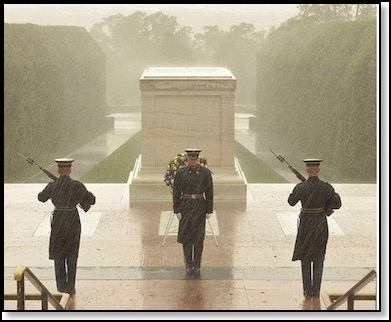
One additional bit of trivia for the day is about how the concept for the Unknown Soldier came about. Sites are not just located in the United States where we are most familiar as Americans. Here is some background to read about how an unknown soldier is selected. We have visited the Tomb in Arlington Cemetery and it is solemn and inspiring.

Caravaggio
23/08/14 20:14 Filed in: Interests
Bob and I have visited art museums in a number of locations. We both have seen the work of Caravaggio. I can’t remember if it was in London or if in San Francisco. The painting was stunning and had so much emotional impact. I came across this piece about a Caravaggio painting that had been lost for many years. It had been long in the dining hall of a Jesuit location in Dublin. Quite a strange mystery surrounding this. The painting is called “The Taking of Christ”.
Some pictures depict mysteries; others have mysteries attached to them. Caravaggio's "The Taking of Christ," a painting that now hangs proudly on a wall in the National Gallery of Ireland, fits into both categories. For almost two centuries it had gone missing.
Some pictures depict mysteries; others have mysteries attached to them. Caravaggio's "The Taking of Christ," a painting that now hangs proudly on a wall in the National Gallery of Ireland, fits into both categories. For almost two centuries it had gone missing.
The Cairo
30/06/14 18:35 Filed in: Travel
One of the most remarkable pieces of the Vicksburg Civil War site is the exhibit of the Cairo (pronounced kay-row). It is an ironclad ship that was sunk in 1862 by Confederates as it tried to steam past Vicksburg. The ship was sunk to the bottom of the channel until it was found and raised through extensive work in the 1960s. One of the cannon carriages is maintained in the museum plus a number of items used in the daily lives of the men aboard the ship. The exhibit is under a sail-like cover and open air. It is an amazing piece of history. Seven ironclads were built. This was the only one sunk yet preserved. Those not sunk were de-commissioned and scuttled.
The Cairo
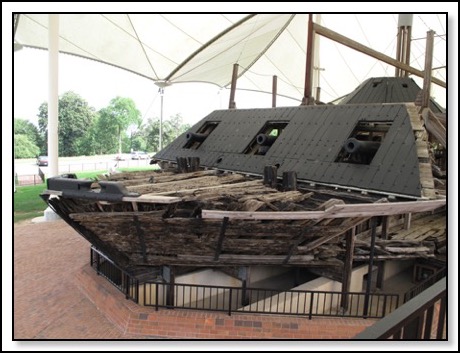
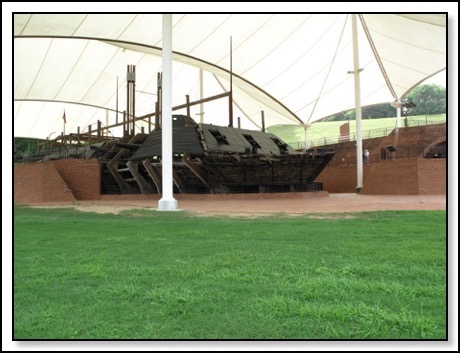
The Cairo


Rare Old Photos
15/06/14 20:14 Filed in: Interests
Every now and then, an internet site has an article that displays rare photos of past events. This article is an example and has a number of interesting photos ranging over the many decades photography has been available.
The Deadly Flu
30/04/14 06:43 Filed in: Interests
In a fascinating part of history, the time of the Spanish Flu in 1918 is at once intriguing and devastating. More people died from the Spanish Flu than in the War to End all Wars, World War I. Many of the dead were the overly healthiest, younger people in their 20s and 30s. Why did they die in higher numbers? No one really has known the answer to date, yet now researchers feel they have found it. One key issue is that young people were more susceptible to secondary bacterial infections that more easily lead to death. The other is the more common strain of the flu picked up genetic material from bird flu about the year 1900. Read about it here.
“Exposure to previous strains of flu virus does offer some protection to new strains. This is because the immune system reacts to proteins on the surface of the virus and makes antibodies that are summoned the next time a similar virus tries to infect the body.
But the further away the new strain is genetically from the ones the body has previously been exposed to, the more different the surface proteins, the less effective the antibodies and the more likely that infection will take hold.”
“Exposure to previous strains of flu virus does offer some protection to new strains. This is because the immune system reacts to proteins on the surface of the virus and makes antibodies that are summoned the next time a similar virus tries to infect the body.
But the further away the new strain is genetically from the ones the body has previously been exposed to, the more different the surface proteins, the less effective the antibodies and the more likely that infection will take hold.”
Fascism and Communism
Jonah Goldberg has written a number of articles and a book about the twin political beliefs, fascism and communism. In this article, he gives the argument again that a political theories, they are not opposites as many portray them. They are actually closely related with different economic arms to that particular political philosophy. I agree with his take on it though I am sure there would be plenty of heavy debate on that statement. His article can be found here. The current situation occurring between Russia, the Ukraine, and the Crimea demonstrates quite nicely how this operates in real time.
Richard III and DNA Testing
12/02/14 12:40 Filed in: History
I have written a few times about the finding of Richard III’s skeleton under a carpark in mid-England at Leicester. The last reference was just a few days ago when I mentioned the determination that Charlemagne’s bones were most likely truly his. The researchers at the University of Leicester have decided that they will try to have Richard III’s DNA sequenced. They believe it will help them determine his history and health. a description of the plan can be read here.


Top 10 Bad Decisions of 20th Century
28/01/14 10:15 Filed in: History
Here we go again, another Top 10 list. This one is the Top 10 bad decisions of the 20th Century. They all seem to be related to wartime decisions. It is interesting to consider a counterfactual scenario of what would have happened if that decision or that action did not happen. I think the list is all justifiable as determined. Some may shift one item out and another in as they consider what is important to them. The list can be found here.
World War I and After
14/01/14 09:03 Filed in: Interests
As I mentioned on a previous post of January 1, there is a lot of commentary about current world status opposed to factors surrounding pre-World War I days, during and then post-war changes. This is all stemming from the centennial time for the beginning of World War I. Part of this article supposes that the after effects of World War I changed the political environment enough to grow Progressivism and the advance of the administrative state. How are does that relate to today? How are Progressives from that time alike or different from today’s. Could the world commit suicide again 100 years later?
Nuclear Test Site Photos
12/01/14 19:18 Filed in: Interests
I came across an interesting article that showed some of the “light glare” to the sky from the nuclear tests done in Nevada northwest of Las Vegas. A lot of this glare could be seen in the skies around Los Angeles. The photos bring back memories of “hiding under your desk”, fallout shelters, and emergency test ban radio. The article talks about the radiation cloud drifting in the direction of Utah. Certainly there was concern that St. George UT was affected and that some movie actors could have developed cancer later in life due to this exposure. The actors would include John Wayne and Susan Hayward as two of those mentioned. Take a gander here.
Thanksgiving and War
28/11/13 14:48 Filed in: Interests
A quiet day of Thanksgiving for just the two of us. We made an awesome meal with plenty of food though toned down on the fats and sugars for a change. We watch some TV, a lot of the Godfather series since it was featured. At the same time, I can across this article on this peaceful day which contemplates “Why should we study war?” Why indeed. Let us hope we can avoid such a calamity though with the diplomatic furbelows and misunderstandings of the current times, I don’t know if I hold my breath for peace. We shall see.
Military History Books
28/10/13 10:41 Filed in: Interests
Victor Davis Hanson, an author of history and military aspects of it, has listed some of his recommended books for reading on Pajamas Media. He is an exceptional author in my opinion, well above my intelligence level. Other writers have their selections in this section of the website. Check it out here.
Society and Revolution
23/10/13 08:40 Filed in: Interests
Investor’s Business Daily has an 8 part series of articles exploring society, socialism, communism, and our lives. The first part is on France and the propaganda of the French Revolution. The eighth part is on Lenin and the disintegration of marriage. I have not gone through all the parts yet wish to post here for future reading and other’s interest.
Webster Knows Dictionaries
22/08/13 20:59 Filed in: Interests
The man who developed the first U.S. dictionary was Noah Webster. He was a lesser known Founding Father. He helped to build the U.S. Census, develop worker’s compensation, copyright law, and benefits to others along with publishing the first dictionary for our country. The book sold over 100 million copies. His cousin was Sen. Daniel Webster so it was a talented family all around. To learn more about him, look here.
Lawrence of Arabia
19/08/13 09:53 Filed in: Interests
I was off to a day of relief work in Eugene. Time to get back into the swing of things and thinking veterinarian so not much time to ponder blog articles and post. Here is another look at T.E. Lawrence, or Lawrence of Arabia fame. His impact appears to live on to this day in the Middle East. Interesting discussion that he was a bit of a self-promoter.
Colorized Photos
18/08/13 09:47 Filed in: Interests
What a pleasure to view old black and white photos from the past that have been colorized.It gives the scene and past another perspective. Maybe the colorization brings the scene more into reality versus a remoteness when viewed. Here is a post with some examples, one from the Civil War era. An extended look of the group of photos is also here.
England and the Raj
The historical underpinnings of India as a part of the English empire has been controversial. Belief was that India, its resources, and its people were exploited by the British. There is an article and recent book that states British rule most likely gave India its basis as an economically growing country. Read the whole article here.
The period of colonial rule, spanning some 200 years, is routinely depicted as the systematic plundering of a nation. The popular view is that the Empire stripped India of its natural resources and gave little in return, leaving the place all but destitute when independence was finally granted in 1947.
Now, however, a new book written by an Anglo-Indian challenges this notion. It asserts that in fact Britain laid the foundations for modern-day India and the prosperity that it enjoys today.
The period of colonial rule, spanning some 200 years, is routinely depicted as the systematic plundering of a nation. The popular view is that the Empire stripped India of its natural resources and gave little in return, leaving the place all but destitute when independence was finally granted in 1947.
Now, however, a new book written by an Anglo-Indian challenges this notion. It asserts that in fact Britain laid the foundations for modern-day India and the prosperity that it enjoys today.
The Man Who Would Be King
10/04/13 09:29 Filed in: Interests
Rudyard Kipling is considered one of England’s greatest poets and authors. He certainly held large sway on the public during the lead up and time of World War I. His writings of the Indian sub-continent certainly carried the imagination of many people. I became more focused on him an a person when watching the movie, My Boy Jack, which told of Kipling’s gung ho support for England aggressively pursuing war against the German Empire in World War I. That passion stirred his son, Jack, to join the military where his life was lost as so many young men did in those times. Kipling felt the loss keenly because he felt he was much the cause of it. I had read some of his work though not “The Man Who Would Be King”. A fascinating read from a great writer. Please read the short story here.
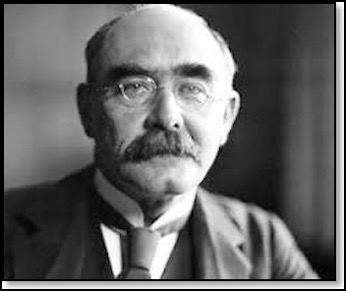

Japanese Revolutionary
03/04/13 11:36 Filed in: Interests
Sakamoto Ryoma was a revolutionary during the times of Japan’s exposure to Western Culture. He saw Commodore Matthew Perry’s ships come into Tokyo harbor in 1853. One can see his story here.
Sakamoto Ryoma is easily one of the most famous and influential people in Japanese history. Idealized by many Japanese boys, Sakamoto led a revolution to overthrow the Tokugawa shogunate during the Bakumatsu period. Tales of his charisma and bravery have been heralded and praised in media ever since. His life was cut short by assassination at the tender age of 31, but his legacy will live on forever.
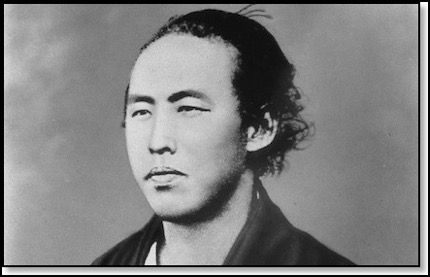
Sakamoto Ryoma is easily one of the most famous and influential people in Japanese history. Idealized by many Japanese boys, Sakamoto led a revolution to overthrow the Tokugawa shogunate during the Bakumatsu period. Tales of his charisma and bravery have been heralded and praised in media ever since. His life was cut short by assassination at the tender age of 31, but his legacy will live on forever.

Banality of Evil
29/03/13 08:57 Filed in: History
Throughout history, people with evil intentions to others have arisen. Hitler, Stalin, Pol Pot, Saddam Hussein, Eichmann, Qaddafi are all of that ilk. Yet, later on in life, some of these people are found in small walks of life living simply and not like the power players they think are.
Great evil never rises to the occasion. We have expectations of it that are never met. The philosopher Hannah Arendt gave us that singular lesson in her extraordinary Eichmann in Jerusalem, first published in 1963. The crimes had been monumental, but the man she glimpsed in a glass booth was a disappointment: “medium-sized, slender, middle-aged, with receding hair, ill-fitting teeth, and nearsighted eyes, who throughout the trial keeps craning his scraggy neck toward the bench.” The very ordinary—“banal”—man, and the extraordinary crimes.
A further discussion is found here.

Great evil never rises to the occasion. We have expectations of it that are never met. The philosopher Hannah Arendt gave us that singular lesson in her extraordinary Eichmann in Jerusalem, first published in 1963. The crimes had been monumental, but the man she glimpsed in a glass booth was a disappointment: “medium-sized, slender, middle-aged, with receding hair, ill-fitting teeth, and nearsighted eyes, who throughout the trial keeps craning his scraggy neck toward the bench.” The very ordinary—“banal”—man, and the extraordinary crimes.
A further discussion is found here.

The Searchers
09/03/13 09:05 Filed in: History
Considered one of the best and most classic Westerns in movie genre is The Searchers with John Wayne. The story behind the John Ford directed movie is the capture of Cynthia Parker as a young girl by Comanche raiders and her life as a Native American captive until rescued. One of her offspring was Quanah Parker, a legend in Comanche lore, and Texas history. He became a large landowner in Texas after living and fighting as a Comanche. A recent book describes the making of the movie and our struggle as we tamed the West with settlers with the Native American peoples. For another take on this topic and book, the Wall Street Journal has this article
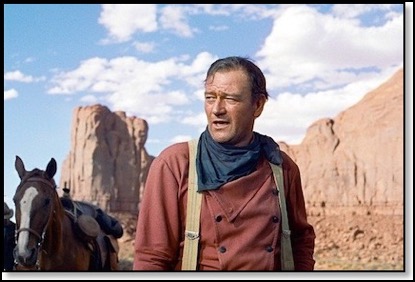
John Wayne in The Searchers
Two more articles on this topic can be found here and here.

John Wayne in The Searchers
Two more articles on this topic can be found here and here.
A Blood Feud
02/03/13 09:02 Filed in: Interests
History has made much of the Hatfield and McCoy feud along the Kentucky-West Virginia border. More broadly damaging yet less spoken of is the blood feud or hatred between Robert Kennedy and Lyndon Johnson. Bill O’Reilly covered it in his recent book, Killing Kennedy.
Robert Caro has written the fourth volume of a 5 volume history of Johnson. A lot of the book covers this feud and its impact on the people around them and also American history. A description of this feud is covered in the New York Times Book Review of Caro’s book here.
Robert Caro has written the fourth volume of a 5 volume history of Johnson. A lot of the book covers this feud and its impact on the people around them and also American history. A description of this feud is covered in the New York Times Book Review of Caro’s book here.
How Wars Start
23/02/13 20:33 Filed in: Interests
It is not the ArchDuke Ferdinand flash of a match that starts a war. It is the underlying problem and volcano of issues that build the real reason. The desire for territory or power, the resentment of a possible lack of respect or face in front of your peers. The article linked here give a good discussion of where the deeper meaning lies to start our greatest wars.
World War II Bunkers
24/02/13 20:26 Filed in: Photography
If you want to see what can be made of long abandoned World War II bunkers in France, Holland, and Belgium, check out this article and the photographs taken of the bunkers in different lighting and in the winter. A lot of history and most likely the stories of men’s lives all wrapped up in these concrete “mansions”.
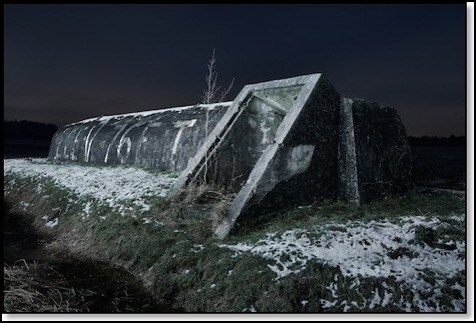

Osama bin Laden Raid
12/02/13 13:54 Filed in: Politics
Phil Bronstein wrote a fascinating piece for Esquire Magazine that describes the raid to kill Osama bin Laden. The article also focuses on the special forces units that do such daring work behind the scenes and how hard it is to re-assimilate back into a normal lifestyle.
The Plantagenets
05/02/13 16:56 Filed in: Interests
With the discovery of Richard the III’s bones, a recent article online discussed the over 300 period the Plantagenet’s ruled England. The period began with Henry II, son of Queen Maude and Geoffrey of Anjou, and ended with the death of Richard. Henry the VIII did all he could to eliminate Plantagenet descendants who could have been a threat to the Tudor dynasty. He did a good job though some did carry through. I love the Plantagenet’s and their strong, often ruthless history. They were what drew me to love English history. It is fun to see it carried into today’s current news.


Old Bones
04/02/13 10:00 Filed in: Interests
Exciting news today! They have confirmed that the skeleton located under a Leicester car park is the skeleton of King Richard lll of England. He was killed at the Battle of Bosworth in 1485 at the end of the War of the Roses. The used the DNA of direct descendants of his sister, Anne of York, to confirm. The plans are to reinter his remains at Leicester Cathedral early next year. Here is information regarding how this historical find came about.


Old WWI Photos
31/01/13 09:15 Filed in: Interests
I have mentioned similar information on the blog in past days about World War I. I have numerous books and photo books of the history of World War I, the war to end all wars. There was a recent story about some photos that have come to light about this War. These photos can be accessed here.
Many individuals experiences in that war shaped their future achievements-- C.S. Lewis, Rudyard Kipling, J.R. Tolkien. Novels such as by Sebastian Faulk can give a feel of what soldiers experienced in that troubling time.
Here is a description from C.S. Lewis:
Although Lewis rarely spoke of his war experiences, he did touch on the subject in his 1955 partial autobiography “Surprised by Joy”:
Through the winter, weariness and water were our chief enemies. I have gone to sleep marching and woken again and found myself marching still. One walked in the trenches in thigh gum boots with water above the knee; one remembers the icy stream welling up inside the boot when you punctured it on concealed barbed wire.
Familiarity both with the very old and the very recent dead confirmed that view of corpses which had been formed the moment I saw my dead mother.
I came to know and pity and reverence the ordinary man: particularly dear Sergeant Ayres, who was (I suppose) killed by the same shell that wounded me. I was a futile officer (they gave commissions too easily then), a puppet moved about by him, and he turned this ridiculous and painful relation into something beautiful, became to me almost like a father.
But for the rest, the war – the frights, the cold, the smell of H. E. (high explosives), the horribly smashed men still moving like half-crushed beetles, the sitting or standing corpses, the landscape of sheer earth without a blade of grass, the boots worn day and night till they seemed to grow to your feet – all this shows rarely and faintly in memory. It is too cut off from the rest of my experience and often seems to have happened to someone else.
Many individuals experiences in that war shaped their future achievements-- C.S. Lewis, Rudyard Kipling, J.R. Tolkien. Novels such as by Sebastian Faulk can give a feel of what soldiers experienced in that troubling time.
Here is a description from C.S. Lewis:
Although Lewis rarely spoke of his war experiences, he did touch on the subject in his 1955 partial autobiography “Surprised by Joy”:
Through the winter, weariness and water were our chief enemies. I have gone to sleep marching and woken again and found myself marching still. One walked in the trenches in thigh gum boots with water above the knee; one remembers the icy stream welling up inside the boot when you punctured it on concealed barbed wire.
Familiarity both with the very old and the very recent dead confirmed that view of corpses which had been formed the moment I saw my dead mother.
I came to know and pity and reverence the ordinary man: particularly dear Sergeant Ayres, who was (I suppose) killed by the same shell that wounded me. I was a futile officer (they gave commissions too easily then), a puppet moved about by him, and he turned this ridiculous and painful relation into something beautiful, became to me almost like a father.
But for the rest, the war – the frights, the cold, the smell of H. E. (high explosives), the horribly smashed men still moving like half-crushed beetles, the sitting or standing corpses, the landscape of sheer earth without a blade of grass, the boots worn day and night till they seemed to grow to your feet – all this shows rarely and faintly in memory. It is too cut off from the rest of my experience and often seems to have happened to someone else.
Missed The Titanic
30/01/13 09:03 Filed in: Interests
The Smithsonian also had another article on their site about seven important people who missed sailing on the Titanic and therefore, lived. One was Theodore Dreiser, an author of An American Tragedy, a novel that was the source for the movie, A Place in the Sun. I bring this up after seeing a web page that discussed who they considered the top 10 horrible of the horrible people in novels. The male figure in the Dreiser novel is one who comes to mind when he kills his fiancé to be with another woman he fancies better.
Also, one of the seven is Marconi, the pioneer in wireless radio signals. We visited the site on Cape Breton Island, Glace Bay, where Marconi had his wireless tower located on this side of the Atlantic. Read about it here.
Also, one of the seven is Marconi, the pioneer in wireless radio signals. We visited the site on Cape Breton Island, Glace Bay, where Marconi had his wireless tower located on this side of the Atlantic. Read about it here.
Into The Wild
29/01/13 08:57 Filed in: Interests
Fascinating story online on the Smithsonian Magazine website about a family of Old Believers, a religious group in the Soviet Union, who retreated deep into the forests of Siberia prior to World War II. They were not noticed until 1978 when petroleum engineers were exploring energy producing sites. The family had not had contact with anyone in the outside world for almost 40 years. They lived off the land and often were starving as a result. The mother did die of starvation when a long, cold Siberian spring damaged any food crop they had.
Romany History
15/01/13 15:23 Filed in: Interests
In the 1990s, Bob and I made a trip to Devon by way of Salisbury and Winchester. We traveled down a busy main 2 lane road that headed toward Exeter. We were faced at one point with a fascinating spectacle not seen here in the United States. In the opposite lane approaching us was a Romany wagon being pulled by 2 horses and lead by a Romany man, young, with his family in the wagon. Behind the wagon, there was a long line of cars waiting for an opportunity to pass. The present rushing to meet the past and go beyond. A clash of cultures. I will never forget that scene because of the contrast and seeing history coming up to meet us.
For an interesting discussion of how the Romany migrated from northwest India to Europe and how they have been able to track that migration through genetics, please read here.
For an interesting discussion of how the Romany migrated from northwest India to Europe and how they have been able to track that migration through genetics, please read here.
19th Century Germany
16/01/13 15:17 Filed in: Interests
General Lee
17/01/13 15:07 Filed in: Interests
I have written in this blog about General Grant. His opposite in the Civil War was General Robert E. Lee. No question another leader who inspires leadership and devotion from the people he led. An example mentioned….
To invoke such a presence, to feel it like old music always new, invariably gives pause. The young officer in Stephen Vincent Benet's "John Brown's Body" pauses before he enters Lee's tent to deliver his dispatch. Looking at the shadow of the figure within bent over his papers, knowing that The War is inevitably winding down, the messenger can only wonder:
What keeps us going on? I wish I knew. Perhaps you see a man like that go on. And then you have to follow.
To read more about this, look here.
To invoke such a presence, to feel it like old music always new, invariably gives pause. The young officer in Stephen Vincent Benet's "John Brown's Body" pauses before he enters Lee's tent to deliver his dispatch. Looking at the shadow of the figure within bent over his papers, knowing that The War is inevitably winding down, the messenger can only wonder:
What keeps us going on? I wish I knew. Perhaps you see a man like that go on. And then you have to follow.
To read more about this, look here.
Single Malts
19/01/13 14:51 Filed in: Interests
An interesting story about how they found rare bottles of scotch whiskey beneath the floor boards of Antarctic explorer Ernest Shackleton’s expedition base. It is an interesting story about what they did with them.
Talk about whisky on ice: Three bottles of rare, 19th century Scotch found beneath the floor boards of Antarctic explorer Ernest Shackelton's abandoned expedition base were returned to the polar continent Saturday after a distiller flew them to Scotland to recreate the long-lost recipe…..Bottled in 1898 after the blend was aged 15 years, the Mackinlay bottles were among three crates of Scotch and two of brandy buried beneath a basic hut Shackleton had used during his dramatic 1907 Nimrod excursion to the Antarctic. The expedition failed to reach the South Pole but set a record at the time for reaching the farthest southern latitude. Shackelton was knighted after his return to Great Britain.

Talk about whisky on ice: Three bottles of rare, 19th century Scotch found beneath the floor boards of Antarctic explorer Ernest Shackelton's abandoned expedition base were returned to the polar continent Saturday after a distiller flew them to Scotland to recreate the long-lost recipe…..Bottled in 1898 after the blend was aged 15 years, the Mackinlay bottles were among three crates of Scotch and two of brandy buried beneath a basic hut Shackleton had used during his dramatic 1907 Nimrod excursion to the Antarctic. The expedition failed to reach the South Pole but set a record at the time for reaching the farthest southern latitude. Shackelton was knighted after his return to Great Britain.

Greenland
14/01/13 11:42 Filed in: Interests
Being a fan of history and also having visited Scandinavia, I found this article on what archeologists have discovered what they believe are the reasons the Viking settlements were abandoned in Greenland in the late 15th century. They do not believe it was due to starvation and disease but more due to economic and identity issues. For the full article, go here.
So, if it wasn't starvation or disease, what triggered the abandonment of the Greenland settlements in the second half of the 15th century? The scientists suspect that a combination of causes made life there unbearable for the Scandinavian immigrants. For instance, there was hardly any demand anymore for walrus tusks and seal skins, the colony's most important export items. What's more, by the mid-14th century, regular ship traffic with Norway and Iceland had ceased.
As a result, Greenland's residents were increasingly isolated from their mother countries. Although they urgently needed building lumber and iron tools, they could now only get their hands on them sporadically. "It became more and more difficult for the Greenlanders to attract merchants from Europe to the island," speculates Jette Arneborg, an archeologist at the National Museum of Denmark, in Copenhagen. "But, without trade, they couldn't survive in the long run."
The settlers were probably also worried about the increasing loss of their Scandinavian identity. They saw themselves as farmers and ranchers rather than fishermen and hunters. Their social status depended on the land and livestock they owned, but it was precisely these things that could no longer help them produce what they needed to survive.
Although the descendants of the Vikings had adjusted to life in the north, there were limits to their assimilation. "They would have had to live more and more like the Inuit, distancing themselves from their cultural roots," says Arneborg. "This growing contradiction between identity and reality was apparently what led to their decline."
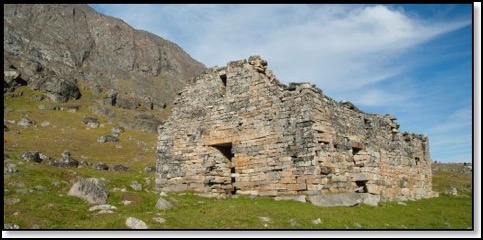
So, if it wasn't starvation or disease, what triggered the abandonment of the Greenland settlements in the second half of the 15th century? The scientists suspect that a combination of causes made life there unbearable for the Scandinavian immigrants. For instance, there was hardly any demand anymore for walrus tusks and seal skins, the colony's most important export items. What's more, by the mid-14th century, regular ship traffic with Norway and Iceland had ceased.
As a result, Greenland's residents were increasingly isolated from their mother countries. Although they urgently needed building lumber and iron tools, they could now only get their hands on them sporadically. "It became more and more difficult for the Greenlanders to attract merchants from Europe to the island," speculates Jette Arneborg, an archeologist at the National Museum of Denmark, in Copenhagen. "But, without trade, they couldn't survive in the long run."
The settlers were probably also worried about the increasing loss of their Scandinavian identity. They saw themselves as farmers and ranchers rather than fishermen and hunters. Their social status depended on the land and livestock they owned, but it was precisely these things that could no longer help them produce what they needed to survive.
Although the descendants of the Vikings had adjusted to life in the north, there were limits to their assimilation. "They would have had to live more and more like the Inuit, distancing themselves from their cultural roots," says Arneborg. "This growing contradiction between identity and reality was apparently what led to their decline."

When Do We Get There?
08/01/13 10:30 Filed in: Travel
Most people who have children should know the refrain, “When do we get there?” My children, especially Scott, was great at asking that question about every 5 minutes on a trip from our home then in Walnut Creek California to family in Oregon.
It is amazing how quickly we can be in one place and later in the day, it seems halfway around the world. London in the morning and San Francisco in the early evening, when it would take days or weeks in the past. Of course, with all the TSA headaches of flight in these days, it can seem to be drug out and exhausting when it is so much better than in the past. I noticed a webpage that showed how long it took to go from one location to another at different times in our history. The information can be found here. Happy journeys!
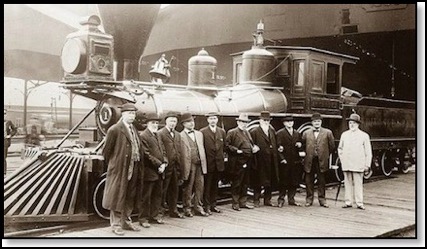
It is amazing how quickly we can be in one place and later in the day, it seems halfway around the world. London in the morning and San Francisco in the early evening, when it would take days or weeks in the past. Of course, with all the TSA headaches of flight in these days, it can seem to be drug out and exhausting when it is so much better than in the past. I noticed a webpage that showed how long it took to go from one location to another at different times in our history. The information can be found here. Happy journeys!

Grant's Regret
09/12/12 08:19 Filed in: Interests
During the Civil War, General Grant issued an order expelling Jews from the army’s Dept. of Tennessee and also from the suppliers for that army. This was a very anti-semitic order which haunted Grant. He came to personally regret his action and believe that he had done a huge injustice to this group of people. Grant went on to compensate for that error and become a huge supporter of the Jewish population. There is a current book discussing this issue. It is one history I have not purchased though I plan to do so at some point. We have a leather bound copy of Grant’s memoirs, considered the best written of any President’s memoirs. A story about Grant’s General Order No. 11 and its impact is here.
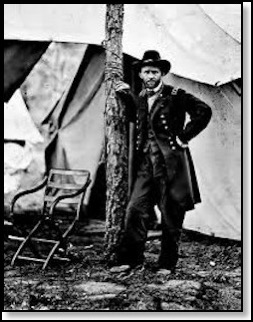

More London Blitz
08/12/12 06:53 Filed in: Interests
My mother’s best friend and co-worker, Irene, later became her sister-in-law and therefore my aunt. Irene was a war bride from London. She would share with Mom some stories of life in London during the bombing. I believe Irene lived in a neighborhood not far from Victoria Station. It was a lower middle class neighborhood. To see how far one could conceive the effect the bombing could have on London, its buildings, and its populace, take a look at this interactive map developed to show where a group has found each bomb landed during the Blitz. Looking at a close view here, there were 2 bombs that landed near the apartment of Tom’s we have stayed at while visiting London. St. Paul’s Cathedral survived the bombing intact as the picture below indicates.
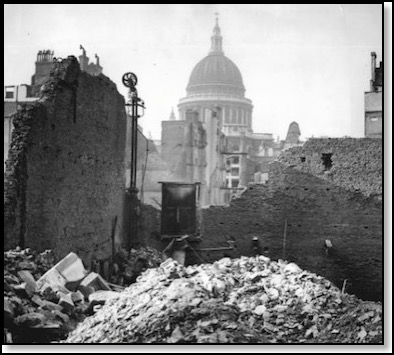

Custer
05/12/12 14:49 Filed in: Interests
One location I would love to see on vacation is the Little Bighorn Battlefield area and also the Black Hills/Mt. Rushmore of South Dakota. Being a history buff, the story of Custer’s last battle is intriguing to follow. I think the best book I have read is Nathan Philbrick’s book, The Last Stand. Larry McMurtry, another very good author, has a new book out titled Custer. An article reviewing his take on Custer’s personality and record was written for the Wall Street Journal Book Review here. Love him or hate him, Custer was not a boring individual. It is a shame that his hubris lost the lives of so many of his relatives and men.


Naval Notes
04/12/12 08:47 Filed in: Interests
A couple of interesting notes in history, past and recent. November 30 was the 60th anniversary of the Battle of Tassafaronga. This was a naval battle the United States fought with the Japanese as they tried to intercept Japanese warships trying to deliver supplies to Guadalcanal. The battle was a strategic victory for the U.S. yet a tactical defeat with the loss of the USS New Orleans. Read about the battle here.
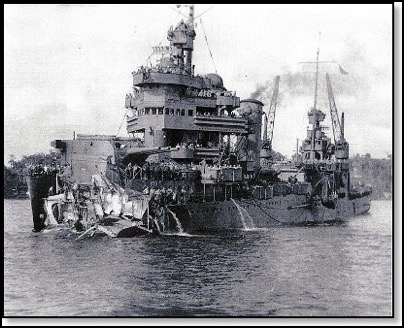
USS New Orleans
The following day lead to a story about the de-commissioning of the USS Enterprise aircraft carrier. The big E has a long and distinguished history. A short reference to the USS Enterprise is here. Another more detailed article also is found in the Weekly Standard. This article covers information about different missions and also about the various men who captained the ship. Because this is a nuclear powered ship, it will take years to de-commission the carrier to remove the nuclear reactors safely. It sounds like the ship will be ported in Norfolk, VA though the article did not seem to be clear on that topic. If all the walls could talk or whisper tails of the men and exploits the Enterprise has seen over its 61 years in action. That may come to pass if this magnificent ship becomes a floating museum as other famous ships have in the past. Enjoy a story of the big E here.
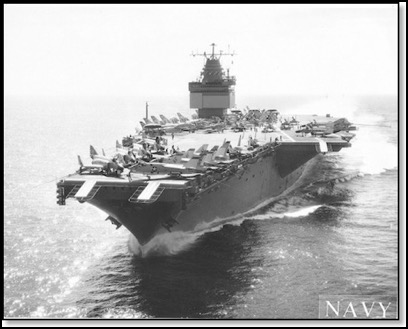
USS Enterprise

USS New Orleans
The following day lead to a story about the de-commissioning of the USS Enterprise aircraft carrier. The big E has a long and distinguished history. A short reference to the USS Enterprise is here. Another more detailed article also is found in the Weekly Standard. This article covers information about different missions and also about the various men who captained the ship. Because this is a nuclear powered ship, it will take years to de-commission the carrier to remove the nuclear reactors safely. It sounds like the ship will be ported in Norfolk, VA though the article did not seem to be clear on that topic. If all the walls could talk or whisper tails of the men and exploits the Enterprise has seen over its 61 years in action. That may come to pass if this magnificent ship becomes a floating museum as other famous ships have in the past. Enjoy a story of the big E here.

USS Enterprise
Faces of the Civil War
27/11/12 20:39 Filed in: Interests
Periodically, one comes across an interesting article, topic, or grouping of pictures. It certainly makes an interesting note to the blog and a way to keep it at hand. I love history and the world behind the Civil War or War Between the States or War of Northern Aggression is an interesting one to follow. We have been fortunate to be able to visit some Civil War battlefields. It is difficult to say which ones are the most interesting though I feel Appomatox in Virginia is the most sad or haunting. One day I will need to add to this post about what made us visit there when we had plans to sightsee elsewhere. What started this post is a grouping of photos called the Faces of the Civil War, check the beginning out here. A second set of the photos can be found in part 2, here. The Liljenquist Family donated over 700 tintypes and ambrotype photographs to the Library of Congress. What a wonderful gesture and part of our history. Many of the people are unidentified. Since my family had those who fought on the side of the North, there is always a remote chance that an ancestor or relative is in one of these photos.
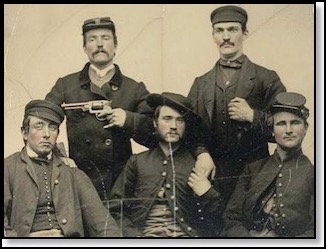
I hope the gun is not loaded.

Oh so young looking!

I hope the gun is not loaded.

Oh so young looking!
War of 1812
While in Nova Scotia, we were able to visit the main city, Halifax. We spent two days there and went to see their version of the Tattoo. The first full day was spent primarily visiting the Citadel which was within a few blocks of our hotel. This fortress was the main military installation for this region and it sits upon a hill overlooking the city of Halifax. They have a lot of students who are hired to be in costume of the day. They give tours and there are a number of videos and tours that can be enjoyed while there. In the main building on the upper floor, they have a military museum. One section of the museum is dedicated to Canada’s involvement in the War of 1812. The war is certainly a factor in our history too. Since this is the 200th anniversary of the war and is a major celebration in some areas. The Atlantic Maritimes were a primary region of Canada affected. One recent article in a Canadian publication, the National Post, has a number of links to topics on this subject.
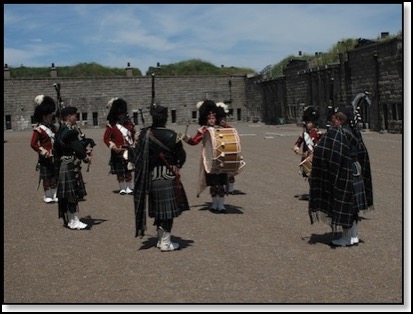
A marching band at the Citadel
Lost Lands
19/11/12 19:04 Filed in: Interests
An interesting graphic came up in a story on The Atlantic Wire. This is a constantly moving map outlining the parts of the United States that were Native American Lands in different times in our history to the present time. It certainly is illuminating and probably distressing to Native Americans when they see it. If someone is interested in seeing this moving map and story, check it out here.
Oldest European Town?
02/11/12 19:36 Filed in: Interests
Archeologists are excavating an area near Provadia, Bulgaria where they believe the remains of the oldest town in Europe is present. They estimate that the settlement was from between 4700 to 4200 B.C. They believe that approximately 350 people lived there and may have worked to mine rock-salt deposits nearby.
To read about this point in history, you can read it here.
To read about this point in history, you can read it here.
Hastings
26/10/12 16:49 Filed in: Interests
It is not exciting to have one of your history beliefs possibly shattered. Though it is interesting at the same time to have new knowledge and recognition come to the forefront.
I just read a recent article that there is a belief that the Battle of Hastings (1066 A.D.) was not fought on Battle Hill near Hastings, but was fought about 1 mile northwest on another hill, Caldbec Hill. They believe that there could be 10,000 bodies from the battle located in that area. Of course, they plan for an archeological exploration of that area. It is sad to think that Bob and I have visited Battle Abbey and walked the Battle of Hastings grounds. We looked over the terrain where so much of English history changed and probably our history here in the States. We were possibly not looking at the true area and missed the real historical spot. Historical concepts will be turned a bit upside down if this is found to be a correct theory and the battlefield is located elsewhere. Just think though of what they may find if they do locate all the remains of soldiers from so long ago.
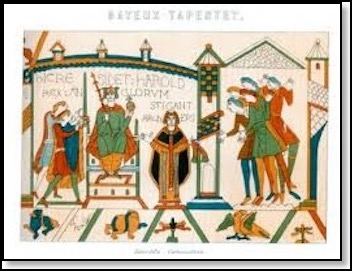
Bayeux Tapestry
I just read a recent article that there is a belief that the Battle of Hastings (1066 A.D.) was not fought on Battle Hill near Hastings, but was fought about 1 mile northwest on another hill, Caldbec Hill. They believe that there could be 10,000 bodies from the battle located in that area. Of course, they plan for an archeological exploration of that area. It is sad to think that Bob and I have visited Battle Abbey and walked the Battle of Hastings grounds. We looked over the terrain where so much of English history changed and probably our history here in the States. We were possibly not looking at the true area and missed the real historical spot. Historical concepts will be turned a bit upside down if this is found to be a correct theory and the battlefield is located elsewhere. Just think though of what they may find if they do locate all the remains of soldiers from so long ago.

Bayeux Tapestry

